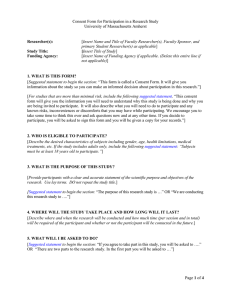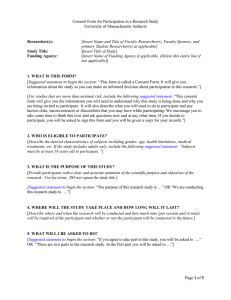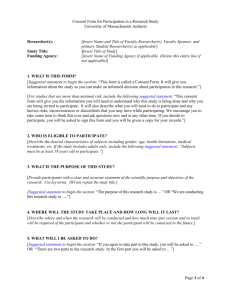Consent Form for Participation in a Research Study
advertisement
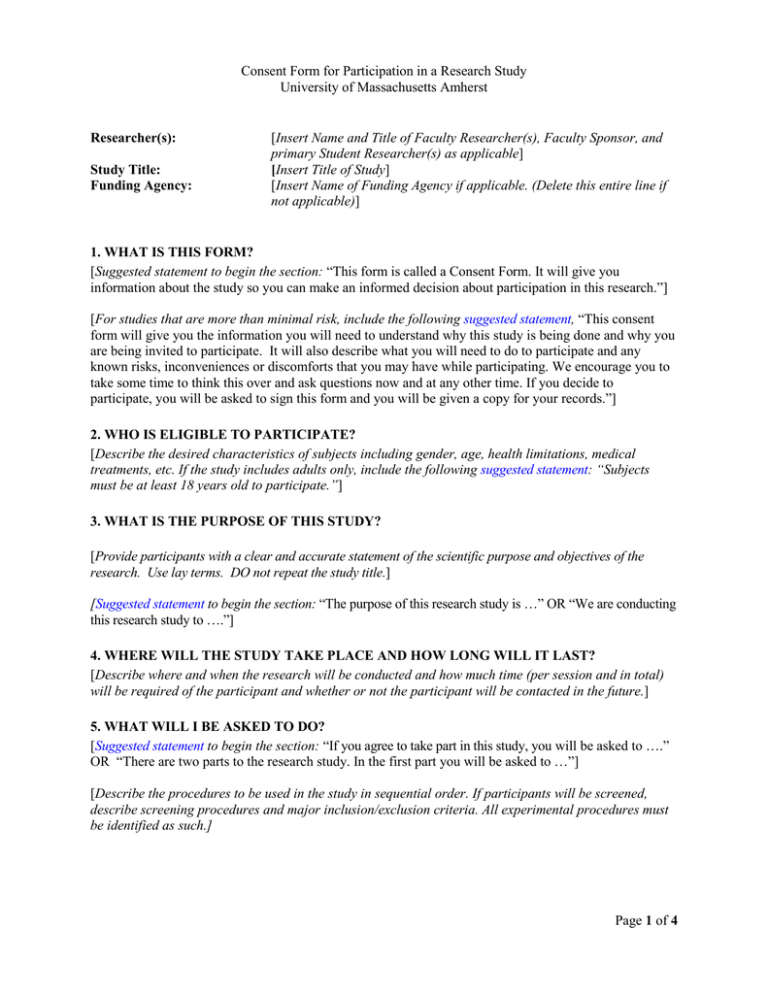
Consent Form for Participation in a Research Study University of Massachusetts Amherst Researcher(s): Study Title: Funding Agency: [Insert Name and Title of Faculty Researcher(s), Faculty Sponsor, and primary Student Researcher(s) as applicable] [Insert Title of Study] [Insert Name of Funding Agency if applicable. (Delete this entire line if not applicable)] 1. WHAT IS THIS FORM? [Suggested statement to begin the section: “This form is called a Consent Form. It will give you information about the study so you can make an informed decision about participation in this research.”] [For studies that are more than minimal risk, include the following suggested statement, “This consent form will give you the information you will need to understand why this study is being done and why you are being invited to participate. It will also describe what you will need to do to participate and any known risks, inconveniences or discomforts that you may have while participating. We encourage you to take some time to think this over and ask questions now and at any other time. If you decide to participate, you will be asked to sign this form and you will be given a copy for your records.”] 2. WHO IS ELIGIBLE TO PARTICIPATE? [Describe the desired characteristics of subjects including gender, age, health limitations, medical treatments, etc. If the study includes adults only, include the following suggested statement: “Subjects must be at least 18 years old to participate.”] 3. WHAT IS THE PURPOSE OF THIS STUDY? [Provide participants with a clear and accurate statement of the scientific purpose and objectives of the research. Use lay terms. DO not repeat the study title.] [Suggested statement to begin the section: “The purpose of this research study is …” OR “We are conducting this research study to ….”] 4. WHERE WILL THE STUDY TAKE PLACE AND HOW LONG WILL IT LAST? [Describe where and when the research will be conducted and how much time (per session and in total) will be required of the participant and whether or not the participant will be contacted in the future.] 5. WHAT WILL I BE ASKED TO DO? [Suggested statement to begin the section: “If you agree to take part in this study, you will be asked to ….” OR “There are two parts to the research study. In the first part you will be asked to …”] [Describe the procedures to be used in the study in sequential order. If participants will be screened, describe screening procedures and major inclusion/exclusion criteria. All experimental procedures must be identified as such.] Page 1 of 4 [If the research involves questionnaires, surveys or interviews, describe the type of questions that will be asked (or the topics covered) and be sure to add the following suggested statement: “You may skip any question you feel uncomfortable answering.”] [If relevant, disclose any alternative procedures or other courses of treatment (if any) that may be advantageous to the subject.] 6. WHAT ARE MY BENEFITS OF BEING IN THIS STUDY? [Describe any direct benefits to the participant that may be reasonably expected as a result of the research. Describe benefits expected to accrue to the population the participant represents or to society in general (e.g. advancement of knowledge, health benefits to others). DO NOT include payments for participation or other incentives and gifts as a benefit of participation.] [If participants are not expected to directly benefit, then use the following suggested statement for this section: “You may not directly benefit from this research; however, we hope that your participation in the study may …(Describe societal benefits).”] 7. WHAT ARE MY RISKS OF BEING IN THIS STUDY? [Inform the participant of any risks (e.g. physical, emotional, social) as a result of study procedures. Each procedure should be identified and then the associated risks described. Identify immediate and latent risks and list them in appropriate order, from most likely to least likely to occur. Identify steps taken to minimize risks. Indicate if there may be unforeseen risks.] [Inform the participant of any inconveniences (e.g. the amount of time required to complete procedures, abstention from food, length of time participants may be required to sit or stand) as a result of study procedures.] [If there are no known risks, then use the following suggested statement in this section: “We believe there are no known risks associated with this research study; however, a possible inconvenience may be the time it takes to complete the study.”] 8. HOW WILL MY PERSONAL INFORMATION BE PROTECTED? [In this section, explain in detail the specific procedures that will be used to protect the study records and subjects’ identity. Include a statement describing how electronic files and data will be secured, maintained, and disposed of.] [Suggested statement to begin section (be sure to describe procedures specific to your study): “The following procedures will be used to protect the confidentiality of your study records. (Please describe all types of study records, including audio and video digital files, if applicable.) The researchers will keep all study records, including any codes to your data, in a secure location. (Describe location, such as a locked file cabinet.) Research records will be labeled with a code. A master key that links names and codes will be maintained in a separate and secure location. The master key and audiotapes will be destroyed (X ) years after the close of the study (insert number of years; typically it is six years if funded and three years if unfunded). All electronic files (include all the types of electronic files that are used, such as databases, spreadsheets, etc.) containing identifiable information will be password protected. Any computer hosting such files will also have password protection to prevent access by unauthorized users. Only the members of the research staff will have access to the passwords. At the conclusion of this study, the researchers may publish their Page 2 of 4 findings. Information will be presented in summary format and you will not be identified in any publications or presentations.”] [If study data is to be released, describe the person(s) or agency to whom information will be furnished, the nature of the information to be furnished, the purpose of the disclosure and whether the participant’s name will be used. This is particularly important for certain vulnerable populations including employees (management access to study data), student athletes (coaching staff access to study data).] [Describe any situations in which confidentiality cannot be guaranteed.] [If a Certificate of Confidentiality is required, describe the extra protection (and limits to such protection) that is afforded. Refer to the HRPO website for a suggested statement to inform participants of this.] [Suggested statement for focus groups research that is minimal risk: “Please be advised that although the researchers will take every precaution to maintain confidentiality of the data, the nature of focus groups prevents the researchers from guaranteeing confidentiality. The researchers would like to remind participants to respect the privacy of your fellow participants and not repeat what is said in the focus group to others.”] [In addition, for research that is above minimal risk it may be useful to include a statement of non-disclosure that participants would agree to. This section should be included near the end of the consent form above the signature line. See section 13 of this template for the suggested wording.] 9. WILL I RECEIVE ANY PAYMENT FOR TAKING PART IN THE STUDY? [If participants will not receive payment, this section is not required.] [Describe any cash payment, gifts, raffle prizes, etc. to participants and the method by which compensation will be paid. Include conditions for partial payment or no payment for early termination. If compensation will be paid in stages, list amount for each stage and the total amount that could be earned for completion of the study.] [For research studies that involve UMASS students receiving extra credit, please describe the specific amount of extra credit participants can earn. Also include the following suggested statement: “If you are earning extra credits through your participation, please understand that this is not the only way to do so. You may contact your instructor who will offer you an appropriate alternative activity.”] 10. WHAT IF I HAVE QUESTIONS? [Suggested statement:“Take as long as you like before you make a decision. We will be happy to answer any question you have about this study. If you have further questions about this project or if you have a research-related problem, you may contact the researcher(s), (insert name(s) and phone number(s)). If you have any questions concerning your rights as a research subject, you may contact the University of Massachusetts Amherst Human Research Protection Office (HRPO) at (413) 545-3428 or humansubjects@ora.umass.edu.”] [For international studies, rather than provide participants with the HRPO phone number, give participants the general HRPO e-mail address – humansubjects@ora.umass.edu. Also, if possible, provide the researchers’ local contact number in the country being studied.] Page 3 of 4 11. CAN I STOP BEING IN THE STUDY? [Suggested statement to begin section: “You do not have to be in this study if you do not want to. If you agree to be in the study, but later change your mind, you may drop out at any time. There are no penalties or consequences of any kind if you decide that you do not want to participate.”] [For longitudinal, interventional and/or treatment studies the following statement is suggested: “You will be notified of all significant new findings during the course of the study that may affect your willingness to continue.”] 12. WHAT IF I AM INJURED? [Suggested statement to begin section: “The University of Massachusetts does not have a program for compensating subjects for injury or complications related to human subjects research, but the study personnel will assist you in getting treatment.”] 13. SUBJECT STATEMENT OF VOLUNTARY CONSENT [Suggested statement: “When signing this form I am agreeing to voluntarily enter this study. I have had a chance to read this consent form, and it was explained to me in a language which I use and understand. I have had the opportunity to ask questions and have received satisfactory answers. I understand that I can withdraw at any time. A copy of this signed Informed Consent Form has been given to me.”] [For focus group research that is above minimal risk, it may be useful to include a statement of nondisclosure that participants would agree to. Suggested statement with checkbox is as follows: I agree to maintain the confidentiality of the information discussed by all participants and researchers during the focus group session. If you cannot agree to the above stipulation please see the researcher(s) as you may be ineligible to participate in this study. Please refer to the levels of review on our website to determine the level of risk for your particular research project: http://www.umass.edu/research/irb-guidelines-levels-review For more information on focus group research, please see our guidelines on our website at http://www.umass.edu/research/irb-guidelines/irb-guidelines .] ________________________ Participant Signature: ____________________ Print Name: __________ Date: By signing below I indicate that the participant has read and, to the best of my knowledge, understands the details contained in this document and has been given a copy. ________________________ Signature of Person Obtaining Consent ____________________ Print Name: __________ Date: Page 4 of 4
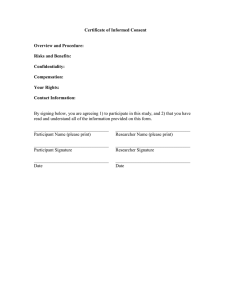
![TEMPLATE CONSENT FORM Good morning/afternoon, my name is [INTERVIEWER’S NAME].](http://s2.studylib.net/store/data/015454953_1-11241969f9c91b19903267ef7d53bcc0-300x300.png)
